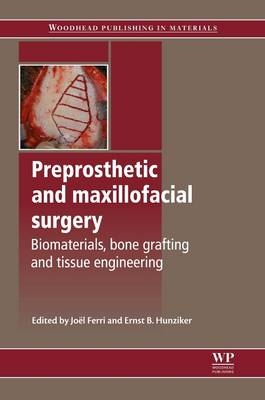
Preprosthetic and Maxillofacial Surgery
Woodhead Publishing Ltd (Verlag)
978-0-08-101737-1 (ISBN)
Professor Joel Ferri is Professor and Head of the Department of Oral and Maxillofacial Surgery at the Roger Salengro Hospital in France. He is highly regarded for his work in the field of preprosthetic and maxillofacial surgery. Professor Ernst B. Hunziker is the Director of the Center of Regenerative Medicine for Skeletal Tissues in Bern, Switzerland and Professor in the Department of Clinical Research at the University of Bern. He is well known for his research and expertise in the field of skeletal tissue engineering.
Contributor contact details
Introduction
Chapter 1: Bone tissue engineering
Abstract:
1.1 Introduction
1.2 Bone-repair strategies
1.3 Biophysical effects
1.4 Distraction osteogenesis
1.5 Biomolecules
1.6 Transplantation of cells
1.7 Flap prefabrication
1.8 Extracorporeal strategies
1.9 Cell systems
1.10 Evaluation of engineering success
Part I: Bone reconstruction in implantology and reconstructive preprosthetic surgery
Chapter 2: Fundamentals of bone grafting in implantology
Abstract:
2.1 Introduction
2.2 Scheme for pre-implant surgery
2.3 Fundamentals of bone grafting
2.4 Local bone grafts
2.5 Distant bone grafts
2.6 Conclusions
Chapter 3: Cranial bone grafting in maxillary preprosthetic surgery
Abstract:
3.1 Introduction
3.2 Experimental studies
3.3 The surgery
3.4 Discussion
3.5 Conclusions
Chapter 4: Maxillary sinus grafting for implant insertion
Abstract:
4.1 Introduction
4.2 Anatomic fundamentals: pathophysiology
4.3 Treatment planning: indications and contraindications
4.4 Types of maxillary sinus augmentation for implant insertion: surgical technique
4.5 Grafting materials
4.6 Results
4.7 Complications of sinus lift
Chapter 5: Symphyseal and alveolar reconstruction in preprosthetic surgery
Abstract:
5.1 Introduction
5.2 The height improvement
5.3 The increase of thickness
5.4 Particular aspects
5.5 Failure risk factors and complications
5.6 Implant placement at the mandibular symphysis
5.7 Indications and limits of the implant placement at the symphysis region
5.8 Conclusions
Chapter 6: Mandible corpus reconstruction for implant insertion: the available techniques
Abstract:
6.1 Introduction
6.2 Anatomical considerations
6.3 Different techniques
6.4 Case studies
6.5 Conclusion and indications
Chapter 7: Alveolar bi-directional distraction in preprosthetic surgery
Abstract:
7.1 Introduction
7.2 Indications for distraction
7.3 Why is a bi-directional distraction necessary?
7.4 Bi-directional distraction device
7.5 Surgical technique for bi-directional distraction
7.6 Insertion of dental implants and suprastructure
7.7 Histology and histomorphometry of distracted bone
7.8 Complications and need for technical improvements
7.9 Conclusions
Chapter 8: Alveolar widening using distraction osteogenesis (DO) in maxillofacial surgery
Abstract:
8.1 Introduction
8.2 Alveolar distraction osteogenesis (DO)
8.3 Horizontal alveolar distraction
8.4 Horizontal periosteal expansion osteogenesis
8.5 Histological evaluation
8.6 Conclusions
Chapter 9: Bone grafting and Le fort I osteotomy in cases of major atrophy of the maxilla
Abstract:
9.1 Introduction
9.2 Anatomical consideration of the maxilla
9.3 The different steps of the technique
9.4 Discussion
9.5 Case study
9.6 Conclusions
Part II: Reconstruction in particular situations
Chapter 10: Applications of biomaterials in alveolar and maxillofacial bone reconstruction
Abstract:
10.1 Introduction
10.2 Substitute materials
10.3 Synthetic inorganic materials
10.4 Synthetic organic materials
10.5 Natural inorganic materials
10.6 Natural organic materials
Chapter 11: Implants in congenital missing teeth
Abstract:
11.1 Introduction
11.2 Diagnosis
11.2 Management
11.4 Rehabilitation cases
11.5 Conclusions
Chapter 12: Maxillo-mandibular amputations and implants rehabilitation
Abstract:
12.1 Introduction
12.2 Strategy for jaw reconstruction
12.3 Basal bone reconstruction
12.4 Preparing endosseous implant-step
12.5 Illustrations of implant-borne prosthesis after jawbone reconstruction
12.6 Conclusions
Chapter 13: Alveolar reconstruction in cleft for implant rehabilitation
Abstract:
13.1 Introduction
13.2 Management of orofacial clefts
13.3 Implant placement in cleft lip and palate (CLP)
13.4 Success rates of implant placement
13.5 Conclusions
Chapter 14: Bone reconstruction in irradiated situations
Abstract:
14.1 Introduction
14.2 Adjuvent treatment
14.3 Non-vascularised bone graft
14.4 Coverage flaps
14.5 Free flap and bone graft association
14.6 Vascularised bone transfers
14.7 New techniques
14.8 Reconstruction principles in irradiated situations
Chapter 15: Periodontal surgery related to alveolar bone reconstruction for implant insertion
Abstract:
15.1 Introduction
15.2 Muco gingival environment around natural teeth
15.3 Role of the keratinized gingiva around the implants
15.4 Developing a favourable environment around the implants
15.5 Surgical technique
15.6 Conclusions
Part III: Tissue engineering
Chapter 16: Mucosal and gingival tissue engineering
Abstract:
16.1 Overview of oral soft tissue wound healing
16.2 Traditional approaches
16.3 Novel approaches for oral soft tissue repair
16.4 Future trends
16.5 Acknowledgments
Chapter 17: Osteoinductivization of dental implants and bone-defect-filling materials
Abstract:
17.1 Introduction
17.2 Biomimetic coating technique
17.3 Conclusions
Chapter 18: Tissue engineering and endodontics
Abstract:
18.1 Introduction
18.2 The dentine-pulp complex
18.3 Pulpal responses to injury
18.4 Pulp capping and dentine-pulp complex regeneration
18.5 Root canal tissue regeneration
18.6 Conclusions
Chapter 19: Tooth regeneration: current status
Abstract:
19.1 Introduction
19.2 Translational barriers of tooth regeneration and dental pulp regeneration
19.3 Cell homing approach for tooth regeneration
19.4 Discussion and future trends
19.5 Acknowledgments
Index
| Erscheinungsdatum | 07.07.2016 |
|---|---|
| Reihe/Serie | Woodhead Publishing Series in Biomaterials |
| Verlagsort | Cambridge |
| Sprache | englisch |
| Maße | 156 x 234 mm |
| Gewicht | 560 g |
| Themenwelt | Medizinische Fachgebiete ► Chirurgie ► Ästhetische und Plastische Chirurgie |
| Medizin / Pharmazie ► Physiotherapie / Ergotherapie ► Orthopädie | |
| Medizin / Pharmazie ► Zahnmedizin | |
| Technik ► Maschinenbau | |
| Technik ► Medizintechnik | |
| Technik ► Umwelttechnik / Biotechnologie | |
| ISBN-10 | 0-08-101737-5 / 0081017375 |
| ISBN-13 | 978-0-08-101737-1 / 9780081017371 |
| Zustand | Neuware |
| Haben Sie eine Frage zum Produkt? |
aus dem Bereich


